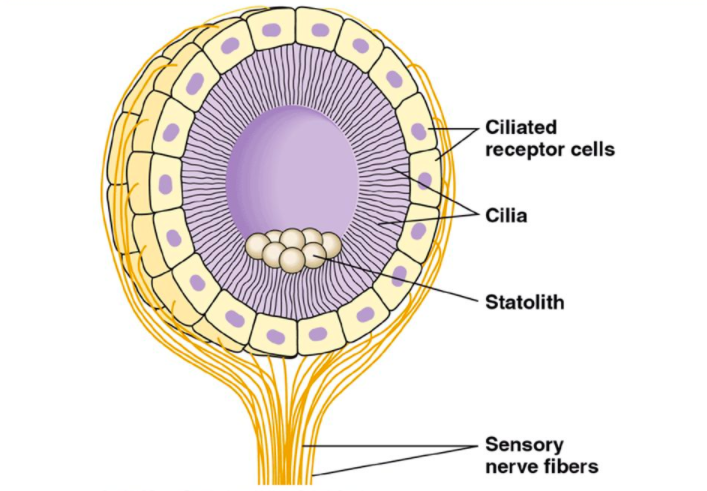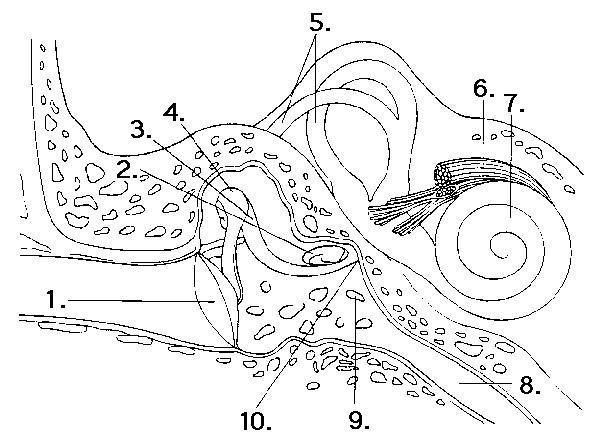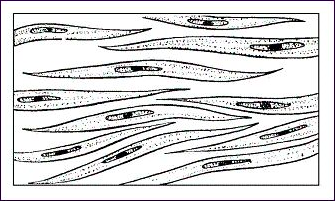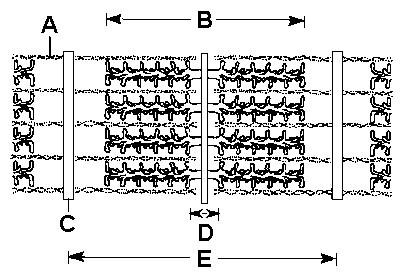1) The 11 pairs of appendages projecting from the rostral area of
star-nosed moles are
A) chemosensory structures.
B)
tactile structures.
C) olfactory structures.
D) highly
sensitive photoreceptors.
E) gustatory structures.
Answer: B
2) The correct sequence of sensory processing is
A) sensory
adaptation → stimulus reception → sensory transduction → sensory
perception.
B) stimulus reception → sensory transduction →
sensory perception → sensory adaptation.
C) sensory perception →
stimulus reception → sensory transduction → sensory adaptation.
D) sensory perception → sensory transduction → stimulus
reception → sensory adaptation.
E) stimulus reception → sensory
perception → sensory adaptation → sensory transduction.
Answer: B
3) Sensory-transducing cells that fire both graded potentials and
action potentials are found in
A) vision.
B) gustation.
C) olfaction.
D) audition.
Answer: C
4) Artificial electrical stimulation of a human's capsaicin-sensitive
neurons would likely produce the sensation of
A) cold
temperature.
B) hot temperature.
C) tactile stimulus.
D) odor of pepper.
E) deep pressure.
Answer: B
5) Artificial electrical stimulation of a human's menthol-sensitive
neurons would likely produce the sensation of
A) cold
temperature.
B) hot temperature.
C) tactile stimulus.
D) odor of pepper.
E) deep pressure.
Answer: A
6) Tastes and smells are distinct kinds of environmental information
in that
A) neural projections from taste receptors reach
different parts of the brain than the neural projections from
olfactory receptors.
B) the single area of the cerebral cortex
that receives smell and taste signals can distinguish tastes and
smells by the pattern of action potentials received.
C) tastant
molecules are airborne, whereas odorant molecules are dissolved in
fluids.
D) distinguishing tastant molecules requires learning,
whereas smell discrimination is an innate process.
E) odorants
bind to receptor proteins, but none of the tastant stimuli bind to receptors.
Answer: A
7) Stimuli alter the activity of excitable sensory cells via
A)
integration.
B) transmission.
C) transduction.
D)
transcription.
E) amplification.
Answer: C
8) Choose the correct sequence of the following events leading to the
sensory processing of a stimulus.
1. transmission
2. transduction
3. integration
4. amplification
A) 1 → 2 → 3 → 4
B) 1 → 4 → 2 → 3
C) 2 → 4 → 1 → 3
D) 3 → 1 → 2 → 4
E) 3 → 1 → 4 → 2
Answer: C
9) Immediately after putting on a shirt, your skin might feel itchy.
However, this perception soon fades due to
A) sensory
adaptation.
B) accommodation.
C) the increase of
transduction.
D) reduced motor unit recruitment.
E)
reduced receptor amplification.
Answer: A
10) A given photon of light may trigger an action potential with
thousands of times more energy because the signal strength is
magnified by
A) the receptor.
B) a G protein.
C) an
enzyme-catalyzed reaction.
D) sensory adaptation.
E)
triggering several receptors at once.
Answer: C
11) The muscle spindle is
A) an actin-myosin complex.
B)
a troponin-tropomyosin complex.
C) axons wound around muscle
fibers.
D) a group of dendrite-encircled muscle fibers.
E)
a muscle cell that makes up a muscle group.
Answer: D
12) Statocysts contain cells that are
A) mechanoreceptors which
function in orientation to gravity.
B) chemoreceptors used in
selecting migration routes.
C) photoreceptors used in setting
biological rhythms.
D) thermoreceptors used in prey detection.
E) chemoreceptors used in acid-base balance.
Answer: A
13) An earthworm without a statocyst would not be able to
A)
move.
B) sense light.
C) hear.
D) orient with
respect to gravity.
E) respond to touch.
Answer: D
14) The cellular membrane across which ion flow varies during
auditory transduction is the
A) tectorial membrane.
B)
tympanic membrane.
C) round-window membrane.
D) hair cell
membrane.
E) basilar membrane.
Answer: D
15) Sound waves arriving at a listener first strike the
A)
tectorial membrane.
B) tympanic membrane.
C) round-window
membrane.
D) hair cell membrane.
E) basilar membrane.
Answer: B
16) The pathway leading to the perception of sound by mammals begins
with the
A) hair cells of the organ of Corti, which rests on the
basilar membrane, coming in contact with the tectorial membrane.
B) hair cells of the organ of Corti, which rests on the tympanic
membrane, coming in contact with the tectorial membrane.
C) hair
cells of the organ of Corti, which rests on the tectorial membrane,
coming in contact with the basilar membrane.
D) hair cells of
the organ of Corti coming in contact with the tectorial membrane as a
result of fluid waves in the cochlea causing vibrations in the round
window.
E) hair cells on the tympanic membrane that stimulate
the tectorial membrane neurons, leading to the auditory section of the brain.
Answer: A
17) The cochlea is an organ of auditory transduction that contains
A) fluid and cells that can undergo mechanosensory transduction.
B) air and cells that produce wax.
C) air and small bones
that vibrate in response to sound waves.
D) fluid with stacks of
chemosensory cells.
E) air and statocysts activated by movement.
Answer: A
18) Dizziness is a perceived sensation that can occur when
A)
the hair cells in the cochlea move more than their normal limits.
B) moving fluid in the semicircular canals encounters a
stationary cupula.
C) rods and cones provide information that
does not correspond with information received by cochlear hair cells.
D) the basilar membrane makes physical contact with the
tectorial membrane.
E) the utricle is horizontal but the saccule
is vertical.
Answer: B
19) The perceived pitch of a sound depends on
A) which part of
the tympanic membrane is being vibrated by sound waves.
B) which
part of the oval window produces waves in the cochlear fluid.
C)
which region of the basilar membrane was set in motion.
D)
whether or not the sound moves the incus, malleus, and stapes.
E) the listener having had training in music.
Answer: C
20) The sand grains or other dense materials resting on
mechanoreceptors used by most invertebrates to sense gravity are
called
A) cochlea.
B) statoliths.
C) stapes.
D) pinnae.
E) antennae.
Answer: A
21) Mechanoreceptors that react to low frequency waves are part of
the
A) human sense of taste.
B) pain receptors in birds.
C) human sense of smell.
D) lateral line systems in fish.
E) eyes in arthropods.
Answer: D
22) The lateral line system in fish transduces sensory information in
a manner that, among these choices, is most similar to
A) human
vision.
B) human olfaction.
C) human gustation.
D)
human vestibular sense.
E) human thermoreception.
Answer: D
23) The generation of action potentials in olfactory neurons
initiated by odors drawn in the nasal cavity is an example of
A)
perception.
B) sensory transduction.
C) sensory
adaptation.
D) habituation.
E) lateral inhibition.
Answer: B
24) Tastes and smells are similar in that
A) both types of
stimuli are present in thousands of different chemicals.
B) both
types of stimuli must be dissolved in a body fluid before they can be
detected.
C) both types of stimuli are proteins (that is,
molecules of very large size and high molecular weight).
D) both
types of stimuli evoke action potentials in the cells to which they
bind.
E) any given stimulus for one system evokes a response
from the other system.
Answer: B
25) Sensillae are
A) smell receptors in animals with
hydrostatic skeletons.
B) mechanoreceptors that help birds
remain oriented during flight.
C) a specific type of hair cell
in the human ear.
D) insect taste receptors found on feet and
mouthparts.
E) olfactory hairs located on insect antennae.
Answer: D
26) Most of the chemosensory neurons arising in the nasal cavity have
axonal projections that terminate in the
A) gustatory complex.
B) anterior hypothalamus.
C) olfactory bulb.
D)
occipital lobe.
E) posterior pituitary gland.
Answer: C
27) Umami perception follows the oral presence of
A) sugar
water.
B) a rich chocolate flavor.
C) a savory and complex
cheese.
D) acidic orange juice.
E) salt water.
Answer: C
28) The ratio of expressed receptor types to taste cells is
A)
~10:1
B) ~100:1
C) ~1,000:1
D) 1:1
E) 1:~100
Answer: D
29) Proteins coded by a very large family of related genes are active
in the sensory transduction of
A) gustatory stimuli.
B)
olfactory stimuli.
C) visual stimuli.
D) auditory stimuli.
E) stimuli related to the position of the head.
Answer: B
30) It can be very difficult to select an angle for sneaking up to a
grasshopper to catch it because grasshoppers have
A) excellent
hearing for detecting predators.
B) compound eyes with multiple
ommatidia.
C) eyes with multiple fovea.
D) a camera-like
eye with multiple fovea.
E) binocular vision.
Answer: B
31) Compared to viewing a distant object, viewing an object held
within 5 cm of the eye requires a lens that
A) has been
flattened, as a result of contraction of the ciliary muscles.
B)
has been made more spherical, as a result of contraction of the
ciliary muscles.
C) has been flattened, as a result of
relaxation of the ciliary muscles.
D) has been made more
spherical, as a result of relaxation of the ciliary muscles.
E)
does not change its shape.
Answer: B
32) Sensory transduction of light/dark information in the vertebrate
retina is accomplished by
A) ganglion cells.
B) amacrine
cells.
C) bipolar cells.
D) horizontal cells.
E)
rods and cones.
Answer: E
33) Rods exposed to light will
A) depolarize due to the opening
of sodium channels.
B) hyperpolarize due to the closing of
sodium channels.
C) depolarize due to the opening of potassium
channels.
D) hyperpolarize due to the closing of potassium
channels.
E) fire one action potential for each photon received.
Answer: B
34) A rod exposed to light will
A) fire action potentials that
will increase its release of glutamate.
B) undergo a graded
depolarization that will increase its release of glutamate.
C)
undergo a graded hyperpolarization that will increase its release of
glutamate.
D) undergo a graded depolarization that will decrease
its release of glutamate.
E) undergo a graded hyperpolarization
that will decrease its release of glutamate.
Answer: E
35) Lateral inhibition via amacrine cells in the mammalian retina
A) underlies habituation of vision.
B) enhances visual
contrast.
C) prevents bleaching in bright light.
D) is
required for color vision to occur.
E) recycles neurotransmitter molecules.
Answer: B
36) For the processing of visual information in the central nervous
system of humans, the neuronal projections of ganglion cells to the
left and right lateral geniculate nuclei (LGN) are
A) all
ipsilateral, meaning that left eye projections stay on the left side
of the brain, and vice versa.
B) all contralateral, meaning that
left eye projections project to the right side of the brain, and vice
versa.
C) ipsilateral for the temporal side of each retina, and
contralateral for the nasal side of each retina.
D) ipsilateral
for the nasal side of each retina, and contralateral for the temporal
side of each retina.
E) randomly crossed in terms of which side
of the retina projects to either the left or right side of the brain.
Answer: C
37) In the human retina
A) cone cells can detect color, but rod
cells cannot.
B) cone cells are more sensitive than rod cells to
light.
C) cone cells, but not rod cells, have a visual pigment.
D) rod cells are most highly concentrated in the center of the
retina.
E) rod cells require higher illumination for stimulation
than do cone cells.
Answer: A
38) Receptor proteins for the neurotransmitter molecules released by
rods and cones are found on
A) ganglion cells.
B)
horizontal cells.
C) amacrine cells.
D) bipolar cells.
E) lateral cells.
Answer: D
39) The blind spot in the human retina is the location that has the
collected axons of
A) ganglion cells.
B) bipolar cells.
C) primary visual cortex.
D) optic chiasma.
E)
lateral geniculate nuclei.
Answer: A
40) An injury to the occipital lobe will likely impair function of
the
A) primary visual cortex.
B) thalamus.
C) optic
chiasma.
D) sense of taste.
E) sense of touch.
Answer: A
41) A ligand for the umami receptor in the sense of taste is
A)
glucose.
B) sodium ions.
C) potassium ions.
D)
hydrogen ions.
E) monosodium glutamate.
Answer: E
42) The olfactory bulbs are located
A) in the nasal cavity.
B) in the anterior pituitary gland.
C) in the posterior
pituitary gland.
D) in the brain.
E) in the brainstem.
Answer: D
43) The contraction of skeletal muscles is based on
A) actin
filaments coiling up to become shorter.
B) myosin filaments
coiling up to become shorter.
C) actin and myosin filaments both
coiling up to become shorter.
D) actin cross-bridges binding to
myosin and then flexing.
E) myosin cross-bridges binding to
actin and then flexing.
Answer: E
44) Compared to oxidative skeletal muscle fibers, those classified as
glycolytic typically have
A) a higher concentration of
myoglobin.
B) a higher density of mitochondria.
C) a
darker visual appearance.
D) a smaller diameter.
E) less
resistance to fatigue.
Answer: E
45) Myasthenia gravis is a form of muscle paralysis in which
A)
motor neurons lose their myelination and the ability to rapidly fire
action potentials.
B) acetylcholine receptors are destroyed by
an overactive immune system.
C) ATP production becomes uncoupled
from mitochondrial electron transport.
D) the spinal cord is
infected with a virus that attacks muscle stretch receptors.
E)
troponin molecules become unable to bind calcium ions.
Answer: B
46) A skeletal muscle deprived of adequate ATP supplies will
A)
immediately relax.
B) release all actin-myosin bonds.
C)
enter a state where actin and myosin are unable to separate.
D)
fire many more action potentials than usual and enter a state of
"rigor."
E) sequester all free calcium ions into the
sarcoplasmic reticulum.
Answer: C
47) Most of the ATP supplies for a skeletal muscle undergoing 1 hour
of sustained exercise come from
A) creatine phosphate.
B)
glycolysis.
C) substrate phosphorylation.
D) oxidative
phosphorylation.
E) de novo synthesis.
Answer: D
48) The calcium ions released into the cytosol during excitation of
skeletal muscle bind to
A) troponin.
B) tropomyosin.
C) actin.
D) myosin.
E) transverse tubules.
Answer: A
49) The "motor unit" in vertebrate skeletal muscle refers
to
A) one actin binding site and its myosin partner.
B)
one sarcomere and all of its actin and myosin filaments.
C) one
myofibril and all of its sarcomeres.
D) one motor neuron and all
of the muscle fibers on which it has synapses.
E) an entire muscle.
Answer: D
50) The muscles of a recently deceased human can remain in a
contracted state, termed rigor mortis, for several hours, due to the
lack of
A) phosphorylated myosin.
B) ATP needed to break
actin-myosin bonds.
C) calcium ions needed to bind to troponin.
D) oxygen supplies needed for myoglobin.
E) sodium ions
needed to fire action potentials.
Answer: B
51) Calcium ions initiate sliding of filaments in skeletal muscles by
A) breaking the actin-myosin cross-bridges.
B) binding to
the troponin complex, which then relocates tropomyosin.
C)
transmitting action potentials across the neuromuscular junction.
D) spreading action potentials through the T tubules.
E)
reestablishing the resting membrane potential following an action potential.
Answer: B
52) Muscle cells are stimulated by neurotransmitters released from
the synaptic terminals of
A) T tubules.
B) motor neuron
axons.
C) sensory neuron axons.
D) motor neuron dendrites.
E) sensory neuron dendrites.
Answer: B
53) In a relaxed skeletal muscle, actin is not chemically bound to
A) myosin.
B) troponin.
C) tropomyosin.
D) Z lines
Answer: A
54) Skeletal muscle contraction begins when calcium ions bind to
A) energized cross-bridges.
B) myosin.
C) actin.
D) tropomyosin.
E) troponin.
Answer: E
55) A skeletal muscle with abnormally low levels of calcium ions
would be impaired in
A) ATP hydrolysis.
B) the initiation
of an action potential.
C) maintaining its resting membrane
potential.
D) initiating contraction.
E) its ability to
sustain glycolysis.
Answer: D
56) Which of the following is the correct sequence that describes the
excitation and contraction of a skeletal muscle fiber?
1. Tropomyosin shifts and unblocks the cross-bridge binding
sites.
2. Calcium is released and binds to the troponin complex.
3. Transverse tubules depolarize the sarcoplasmic reticulum.
4. The thin filaments are ratcheted across the thick filaments
by the heads of the myosin molecules using energy from ATP.
5.
An action potential in a motor neuron causes the axon to release
acetylcholine, which depolarizes the muscle cell membrane.
A) 1 → 2 → 3 → 4 → 5
B) 2 → 1 → 3 → 5 → 4
C) 2 → 3 →
4 → 1 → 5
D) 5 → 3 → 1 → 2 → 4
E) 5 → 3 → 2 → 1 → 4
Answer: E
57) The lumen of the transverse tubules of skeletal muscles contains
A) extracellular fluid.
B) cytosol.
C) actin.
D) myosin.
E) sarcomeres.
Answer: A
58) Sustained muscle contraction without relaxation between
successive stimuli is called
A) tonus.
B) fused tetanus.
C) an all-or-none response.
D) fatigue.
E) a spasm.
Answer: B
59) Skeletal, cardiac, and smooth muscle all have
A) A bands
and I bands.
B) transverse tubules.
C) gap junctions.
D) motor units.
E) thick and thin filaments.
Answer: E
60) Calcium ions regulate contraction of smooth muscle cells by
binding to
A) troponin.
B) tropomyosin.
C) actin.
D) myosin.
E) calmodulin.
Answer: E
61) Action potentials in the heart move from one contractile cell to
the next via
A) chemical synapses using acetylcholine.
B)
chemical synapses using norepinephrine.
C) electrical synapses
using gap junctions.
D) myelinated motor neurons.
E)
non-myelinated motor neurons.
Answer: C
62) The hydrostatic skeleton of the earthworm allows it to move
around in its environment by
A) walking on its limbs.
B)
crawling with its feet.
C) swimming with its setae.
D)
using peristaltic contractions of its circular and longitudinal
muscles.
E) alternating contractions and relaxations of its flagellae.
Answer: D
63) Chitin is a major component of
A) the skeleton of mammals.
B) the hydrostatic skeletons of earthworms.
C) the
exoskeleton of insects.
D) the body hairs of mammals.
E)
the skeleton in birds.
Answer: C
64) An endoskeleton is the primary body support for the
A)
annelids, including earthworms.
B) insects, including beetles.
C) cartilaginous fishes, including sharks.
D) bivalves,
including clams.
E) crustaceans, including lobsters.
Answer: C
65) A ball-and-socket joint connects
A) the radius to the ulna.
B) the radius to the humerus.
C) the ulna to the humerus.
D) the humerus to the scapula.
E) the radius to the scapula.
Answer: D
66) Among these choices, the most energetically efficient locomotion
per unit mass is likely
A) running by a 50-gram rodent.
B)
running by a 40-kg ungulate.
C) flying by a 100-g bird.
D)
swimming by a 10-g minnow (bony fish).
E) swimming by a 100-kg
tuna (bony fish).
Answer: E

67) The structure diagrammed in the figure is the
A) neuromast.
B) statocyst.
C) taste bud.
D) ommatidium.
E)
olfactory bulb.
Answer: B

68) The structure involved in equalizing the pressure between the ear
and the atmosphere is represented by number
A) 7.
B) 1.
C) 8.
D) 9.
E) 10.
Answer: C

69) The sense of head motion begins with sensory transduction by the
structures at which numbers?
A) 2, 3, and 4.
B) 2, 5, and
7.
C) 4.
D) 5.
E) 7 and 8.
Answer: D

70) Vibrations of the tympanic membrane to the oval window are
transmitted by the structures at which numbers?
A) 1, 2, 3, and
4.
B) 2, 3, and 4.
C) 3 and 4.
D) 4.
E) 5.
Answer: C

71) The organ of Corti is represented by which number?
A) 3.
B) 4.
C) 5.
D) 6.
E) 7.
Answer: E

72) Hair cells are found in structures represented by numbers
A) 1 and 2.
B) 3 and 4.
C) 5 and 7.
D) 6 and
8.
E) 9 and 10.
Answer: C

73) The structure pictured in the figure is found in
A) skeletal
muscles and smooth muscles.
B) cardiac muscles and skeletal
muscles.
C) smooth muscles and cardiac muscles.
D) smooth
muscles, skeletal muscles, and cardiac muscles.
E) smooth muscles.
Answer: B

74) Myosin filaments without actin overlap are in which section of
the figure?
A) A
B) B
C) C
D) D
E) E
Answer: D

75) Overlapping actin and myosin filaments are found in which section
of the figure?
A) A
B) B
C) C
D) D
E) E
Answer: B
76) Experiments with genetically altered mice showed that the mice
would consume abnormally high amounts of bitter-tasting compounds in
water after their
A) hormone receptors for digestive hormones
were reduced or eliminated, showing that bitter tastes are reinforced
by digestive responses.
B) salt-taste cells were altered to
express receptors for bitter tastants, suggesting that animals have
unregulated salt appetites.
C) visual sense was reduced or
eliminated, suggesting that mice learn visual cues about bitter
tastes.
D) olfactory sense was reduced or eliminated, suggesting
that mice learn odor cues about bitter tastes.
E) sweet-taste
cells were altered to express receptors for bitter tastants,
suggesting that the sensation of taste depends only on which taste
cell is stimulated.
Answer: E
77) Which of the following sensory receptors is incorrectly paired
with its category?
A) hair cellmechanoreceptor
B) muscle
spindlemechanoreceptor
C) taste receptor–chemoreceptor
D)
rodelectromagnetic receptor
E) olfactory
receptorelectromagnetic receptor
Answer: E
78) The middle ear converts
A) air pressure waves to fluid
pressure waves.
B) fluid pressure waves to air pressure waves.
C) air pressure waves to nerve impulses.
D) fluid pressure
waves to nerve impulses.
E) pressure waves to hair cell movements.
Answer: A
79) During the contraction of a vertebrate skeletal muscle fiber,
calcium ions
A) break cross-bridges by acting as a cofactor in
the hydrolysis of ATP.
B) bind with troponin, changing its shape
so that the myosin-binding sites on actin are exposed.
C)
transmit action potentials from the motor neuron to the muscle fiber.
D) spread action potentials through the T tubules.
E)
re-establish the polarization of the plasma membrane following an
action potential.
Answer: B
80) Which sensory distinction is not encoded by a difference in
neuron identity?
A) white and red
B) red and green
C) loud and faint
D) salty and sweet
E) spicy and cool
Answer: C
81) The transduction of sound waves into action potentials takes
place
A) within the tectorial membrane as it is stimulated by
the hair cells.
B) when hair cells are bent against the
tectorial membrane, causing them to depolarize and release
neurotransmitter that stimulates sensory neurons.
C) as the
basilar membrane becomes more permeable to sodium ions and
depolarizes, initiating an action potential in a sensory neuron.
D) as the basilar membrane vibrates at different frequencies in
response to the varying volume of sounds.
E) within the middle
ear as the vibrations are amplified by the malleus, incus, and stapes.
Answer: B
82) Although some sharks close their eyes just before they bite,
their bites are on target. Researchers have noted that sharks often
misdirect their bites at metal objects and that they can find
batteries buried under sand. This evidence suggests that sharks keep
track of their prey during the split second before they bite in the
same way that
A) a rattlesnake finds a mouse in its burrow.
B) a male silkworm moth locates a mate.
C) a bat finds
moths in the dark.
D) a platypus locates its prey in a muddy
river.
E) a flatworm avoids light places.
Answer: D